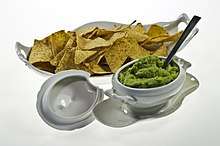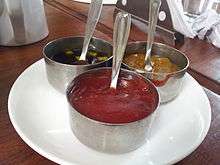Guacamole
Guacamole (Spanish: [(ɡ)wakaˈmole] (![]()
 Guacamole with tortilla chips | |
| Alternative names | Guac |
|---|---|
| Type | Mexican food |
| Place of origin | Mexico |
| Main ingredients | Avocados, sea salt, lime juice |
| Variations | Mantequilla de pobre Guasacaca |
Etymology and pronunciation

The name comes from a dialect of Nahuatl āhuacamolli [aːwakaˈmolːi], which literally translates to "avocado sauce", from āhuacatl[6] [aːˈwakat͡ɬ] ("avocado") + molli [ˈmolːi] ("sauce", literally "concoction").[3] In Mexican Spanish, it is pronounced [wakaˈmole],[7][8] in American English, it tends to be pronounced /ˌɡwɑːkəˈmoʊliː/, and in British English, /ˌɡwɑːkəˈmoʊleɪ/.[9][10]
History
Avocados were first cultivated in South Central Mexico around 10,000 years ago.[11][12][13] In the early 1900s, avocados frequently went by the name alligator pear.[14]
Guacamole has increased avocado sales in the U.S., especially on Super Bowl Sunday and Cinco de Mayo.[15] The rising consumption of guacamole is most likely due to the U.S. government lifting a ban on avocado imports in the 1990s and the growth of the U.S. Latino population.[16]
Ingredients
Guacamole dip is traditionally made by mashing ripe avocados and sea salt with a molcajete y tejolote (mortar and pestle).[17][18] Recipes often call for lime juice, cilantro, and jalapeños. Some non-traditional recipes may call for sour cream, tomatoes, basil, or peas.[19]
Due to the presence of polyphenol oxidase in the cells of avocado, exposure to oxygen in the air causes an enzymatic reaction and develops melanoidin pigment, turning the sauce brown.[20] This result is generally considered unappetizing, and there are several methods (some anecdotal) that are used to counter this effect, such as storing the guacamole in an air-tight container or wrapping tightly in plastic to limit the surface area exposed to the air.[21]
Composition and nutrients
| Nutritional value per 100 g | |
|---|---|
| Energy | 670 kJ (160 kcal) |
8.53 g | |
| Starch | 0.11 g |
| Sugars | 0.66 g 0 |
| Dietary fiber | 6.7 g |
14.66 g | |
| Saturated | 2.126 g |
| Trans | 0 |
| Monounsaturated | 9.8 g |
| Polyunsaturated | 1.816 g |
2.00 g | |
| Vitamins | Quantity %DV† |
| Vitamin A equiv. | 1% 7 μg1% 62 μg271 μg |
| Vitamin A | 146 IU |
| Thiamine (B1) | 6% 0.067 mg |
| Riboflavin (B2) | 11% 0.130 mg |
| Niacin (B3) | 12% 1.738 mg |
| Pantothenic acid (B5) | 28% 1.389 mg |
| Vitamin B6 | 20% 0.257 mg |
| Folate (B9) | 20% 81 μg |
| Choline | 3% 14.2 mg |
| Vitamin C | 12% 10.0 mg |
| Vitamin E | 14% 2.07 mg |
| Vitamin K | 20% 21 μg |
| Minerals | Quantity %DV† |
| Calcium | 1% 12 mg |
| Iron | 4% 0.55 mg |
| Magnesium | 8% 29 mg |
| Phosphorus | 7% 52 mg |
| Potassium | 10% 485 mg |
| Sodium | 0% 7 mg |
| Zinc | 7% 0.64 mg |
| Other constituents | Quantity |
| Water | 73.23 |
| |
| †Percentages are roughly approximated using US recommendations for adults. Source: USDA Nutrient Database | |
As the major ingredient of guacamole is raw avocado, the nutritional value of the dish derives from avocado vitamins, minerals and fats, providing dietary fiber, several B vitamins, vitamin K, vitamin E and potassium in significant content (see Daily Value percentages in nutrient table for avocado). Avocados are a source of saturated fat, monounsaturated fat and phytosterols, such as beta-sitosterol.[22][23] They also contain carotenoids, such as beta-carotene, zeaxanthin and lutein.[24]
Similar foods
Mantequilla de pobre
Mantequilla de pobre (Spanish for '"poor-man's butter"') is a mixture of avocado, tomato, oil, and citrus juice.[25] Despite its name, it predates the arrival of dairy cattle in the Americas, and thus was not originally made as a butter substitute.[4]
Guasacaca
Thinner and more acidic,[26] or thick and chunky,[27] guasacaca is a Venezuelan avocado-based sauce; it is made with vinegar,[28] and is served over parrillas (grilled food), arepas, empanadas, and various other dishes. It is common to make the guasacaca with a little hot sauce instead of jalapeño, but like a guacamole, it is not usually served as a hot sauce itself. Pronounced "wasakaka" in Latin America.[29]

Commercial products
Prepared guacamoles are available in stores, often available refrigerated, frozen or in high pressure packaging which pasteurizes and extends shelf life if products are maintained at 1 to 4 °C (34 to 40 °F).[30]
Holiday
National Guacamole Day is celebrated on the same day as Mexican Independence Day, September 16.[31][32]
In popular culture
On April 6, 2018, Junta Local de Sanidad Vegetal de Tancítaro, Mexico, achieved the Guinness World Records for the largest serving of guacamole. They created it as part of Tancítaro's 7th Annual Avocado Festival in Tancítaro, Michoacán, Mexico. The serving weighed 3,788 kg (8,351 lb) and had more than 350 people help prepare it.[33]
See also
References
- "Oxford Dictionary". Retrieved August 12, 2018.
- "guac | Definition of guac in English by Oxford Dictionaries". Oxford Dictionaries | English. Retrieved August 20, 2018.
- Zeldes, Leah A. (November 4, 2009). "Eat this! Guacamole, a singing sauce, on its day". Dining Chicago. Chicago's Restaurant & Entertainment Guide, Inc. Retrieved November 5, 2009.
- Beard, James; Bittman, Mark (September 4, 2007). Beard on Food: The Best Recipes and Kitchen Wisdom from the Dean of American Cooking. Bloomsbury Publishing USA. pp. 86–87. ISBN 978-1-59691-446-9. Retrieved March 14, 2012.
- Smith, Andrew F. (May 1, 2007). The Oxford companion to American food and drink. Oxford University Press. pp. 144–146. ISBN 978-0-19-530796-2. Retrieved March 14, 2012.
- "How to Pronounce "Guacamole" in Spanish". ThoughtCo. Retrieved August 20, 2018.
- Claudia R. Guerra, ed. (2018). 300 Years of San Antonio and Bexar County. San Antonio, TX: Trinity University Press. p. 55. ISBN 9781595348500.
- Maria de Lourdes Santiago Martínez; Juan López Chávez (2004). Etimologías: introducción a la historia del léxico español. Pearson Educación. p. 241. ISBN 9789702604938.
- "Definition of guacamole in English by Oxford Dictionaries". Oxford Dictionaries English. Retrieved 21 August 2018.
- "Etymology". Retrieved August 12, 2018.
- "What's in a name?". University of California. Retrieved March 27, 2016.
- Chen, H.; Morrell, P. L.; Ashworth, V. E. T. M.; de la Cruz, M.; Clegg, M. T. (2008). "Tracing the Geographic Origins of Major Avocado Cultivars". Journal of Heredity. 100 (1): 56–65. doi:10.1093/jhered/esn068. PMID 18779226.
- Galindo-Tovar, María Elena; Arzate-Fernández, Amaury M.; Ogata-Aguilar, Nisao & Landero-Torres, Ivonne (2007). "The avocado (Persea americana, Lauraceae) crop in Mesoamerica: 10,000 years of history" (PDF). Harvard Papers in Botany. 12 (2): 325–334, page 325. doi:10.3100/1043-4534(2007)12[325:TAPALC]2.0.CO;2. JSTOR 41761865. Archived (PDF) from the original on October 10, 2015.
- Morton JF (1987). Avocado; In: Fruits of Warm Climates. Creative Resource Systems, Inc., Winterville, NC and Center for New Crops & Plant Products, Department of Horticulture and Landscape Architecture, Purdue University, West Lafayette, IN. pp. 91–102. ISBN 978-0-9610184-1-2.
- Charles, Jeffrey (2002). "8. Searching for gold in Guacamole: California growers market the avocado, 1910–1994". In Belasco, Warren; Scranton, Philip (eds.). Food nations: selling taste in consumer societies. Routledge. pp. 131–154. ISBN 978-0-415-93077-2. Retrieved September 20, 2011.
- Khazan, Olga (2015-01-31). "The Selling of the Avocado". The Atlantic. Retrieved September 28, 2016.
- "The best guacamole recipe". Business Insider. Retrieved 21 August 2018.
- Eats, Serious. "The Best Guacamole (and the Science of Avocados) | The Food Lab". www.seriouseats.com. Retrieved 21 August 2018.
- "Green Pea Guacamole". The New York Times. Retrieved October 16, 2016.
- Hartel, 2009, p. 43
- "National Guacamole Day :: Fresh Avocado". avocadocentral.com. Archived from the original on May 17, 2017. Retrieved September 28, 2016.
- "Avocados, raw, all commercial varieties, per 100 grams". NutritionData.com. 2013. Retrieved April 17, 2013.
- "Avocados: Health Benefits, Nutritional Information". MNT. Retrieved January 12, 2016.
- Dreher ML; Davenport AJ (2013). "Hass avocado composition and potential health effects". Crit Rev Food Sci Nutr. 53 (7): 738–50. doi:10.1080/10408398.2011.556759. PMC 3664913. PMID 23638933.
- House & Garden. Condé Nast Publications. 1965. p. 122. Retrieved August 21, 2018.
Mantequilla de pobre is literally “poor man's butter” ...
- "Caracas Calling". New York Press. July 13, 2004. Archived from the original on June 10, 2015. Retrieved March 4, 2010.
- "Guasacaca – Venezuelan-style Guacamole". About.com. July 2, 2009. Retrieved October 6, 2013.
- Serpa, Diego (1968). "Avocado Culture in Venezuela" (PDF). California Avocado Society 1968 Yearbook. 52: 153–168. ISSN 0096-5960. Retrieved March 4, 2010.
- "guasacaca". Oxford Spanish-English Dictionary. Retrieved February 1, 2016. Sound file is at "LAT.AM.SP", to the right of the headword near the top of the window.
- "High-pressure processing ideal for guacamole lovers". The Packer. Retrieved January 12, 2016.
- "National guacamole day!". CBC Kids. Retrieved August 20, 2018.
- "Celebrating Mexican Independence Day, National Guacamole Day". The Arizona Republic. Retrieved August 20, 2018.
- "Largest serving of guacamole". Guinness World Records. Retrieved August 20, 2018.
Bibliography
- Hartel, Richard W and Hartel, AnnaKate (March 1, 2009), Food Bites: the Science of the Foods We Eat; Springer Science & Business Media, ISBN 0387758453
External links




.jpg)
